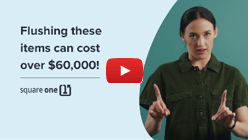The top 10 unflushable items
To put it bluntly, there are basically two things that you can flush down the toilet: human waste, and toilet paper. Despite that, people flush all sorts of things all the time. In some cases, that can lead to a clogged toilet; in worse cases, it can lead to a blockage deeper in the plumbing system and thousands of dollars in damage to your home (as you’ll see below).
This all applies if your home has a septic system, too. In fact, those with septic systems should be even more careful about what they flush down the toilet.
Here is our list of the most common unflushable things that people still try to flush:
1. Flushable wipes
Let’s start at the height of irony, with so-called “flushable” wipes. Spoiler alert: they’re not flushable.
Toilets, plumbing, and sewer systems are all meant to handle materials that break down in water. Flushable wet wipes are designed to maintain their integrity while they sit, wet, in their packaging. Accordingly, they tend to also maintain that integrity while they’re moving through your plumbing system.
If you use wet wipes in your home, dispose of them in the trash instead.
2. Paper towels
Like wet wipes, paper towels are designed to hold together when they get wet. In fact, that’s kind of their main marketing tactic. They may seem similar to toilet paper, but toilet paper is designed to break down quickly as soon as it gets wet.
If you flush paper towels, they won’t break down in your pipes. They can easily get stuck somewhere and cause a serious blockage.
3. Hygiene products
Continuing along the lines of “stuff that’s meant to hold together when it gets wet” we have menstrual hygiene products. Items like tampons and pads not only maintain their integrity when they get wet, they absorb liquid and expand.
Aside from their intended use, they’re almost perfectly designed to block your toilet and your plumbing. Don’t flush them—put them in the trash.
4. Diapers
You might not think that anyone would think of diapers as flushable, given their size (even before they absorb a bunch of water). But, we’ve seen it happen.
Diapers are absolutely not going to dissolve when they get wet, so dispose of them in the trash and not the toilet.
5. Kitty litter
Most kitty litter is made with clay. And when you combine small pellets of clay with a bunch of water, you get a substance that can clog up the toilet and the plumbing system with ease.
You may think it’s harmless, but we’ve seen flushed kitty litter cause over $60,000 in damage to a home. Think about that before you try it.
6. Medication
While medication may not cause problems with your plumbing, you still shouldn’t flush it down the toilet (or dump it down the sink). However, old pills or other medicines can dissolve in water and end up polluting waterways and groundwater.
If you need to dispose of medication, don’t throw it directly in the garbage. You can take it to a pharmacy to dispose of, for one option. Otherwise, remove them from their original packaging and mix them in with something like coffee grounds or kitty litter. Then, seal them in a plastic bag and toss them in the trash.
7. Cigarette butts
Much like medication, cigarettes are full of all sorts of things that we’d rather not have leeching into the water. Cigarette butts may not plug up plumbing on their own, but they can get caught in existing blockages and make them worse, ending with clogged up plumbing and water damage in your home.
8. Random bathroom trash
Bathrooms generate a lot of trash, and much of it is small enough to appear flushable—but it’s not. Cotton swabs, dental floss, makeup removal pads, and all sorts of other small bits of trash get flushed on a regular basis. We’ve even seen a flushed shaving cream cap cause over $2,000 in damage.
Again, many are small enough that they won’t block pipes on their own. But, if they get caught in an existing blockage, they’ll make it worse. If that blockage happens deep inside your plumbing system, you might never find it. You’ll only know about it after things start backing up and damaging your home.
9. Fats and oils
People commonly dump cooking oils and leftover fats down the sink rather than the toilet, but neither one is a good idea.
These things may be liquid when you dump them, but when they meet cool water or undergo various chemical reactions in the sewer system, they become very solid. Fat blockages can be a major problem for your home plumbing system, and a catastrophe for your city’s sewer system.
10. Excess toilet paper
Flushing toilet paper is fine—that’s what it’s for. But too much at once can bunch up and clog your toilet or block your pipes.
While toilet paper will eventually dissolve in water, there’s an interim period between getting wet and dissolving where it acts more like paper mâché. That can result in thousands of dollars in water damage (we’ve seen toilet paper cause over $5,000 in damage before) if the toilet overflows.
Speaking of which, now that we’ve reached the end of our list of unflushables, let’s move on to solutions.




